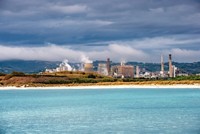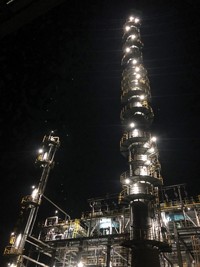Advertisement
Grab your lab coat. Let's get started
Welcome!
Welcome!
Create an account below to get 6 C&EN articles per month, receive newsletters and more - all free.
It seems this is your first time logging in online. Please enter the following information to continue.
As an ACS member you automatically get access to this site. All we need is few more details to create your reading experience.
Not you? Sign in with a different account.
Not you? Sign in with a different account.
ERROR 1
ERROR 1
ERROR 2
ERROR 2
ERROR 2
ERROR 2
ERROR 2
Password and Confirm password must match.
If you have an ACS member number, please enter it here so we can link this account to your membership. (optional)
ERROR 2
ACS values your privacy. By submitting your information, you are gaining access to C&EN and subscribing to our weekly newsletter. We use the information you provide to make your reading experience better, and we will never sell your data to third party members.
Business
A Chemical Hub Fights To Be Greener
To prevent its demise, the chemical sector in Northeast England seeks to reinvent itself as a low-carbon-emission region
by Alex Scott
February 3, 2014
| A version of this story appeared in
Volume 92, Issue 5

Drive past the flaring stacks and shiny distillation towers of Northeast England’s Teesside chemical complex and up to the entrance of the stately red-brick Wilton Centre next door, and you might think that ICI, the British firm that built these facilities, still exists.
But ICI was broken up and sold off a decade ago. Look closely at the chemical complex and you will see the logos of Saudi Basic Industries, Huntsman Corp., and others that now own the plants on the site. The Wilton Centre, once the R&D headquarters for ICI, is now host to more than 60 organizations, including start-ups, universities, and U.K. subsidiaries of international chemical and drug companies.
Northeast England Chemical Sector At A Glance
◾ Status: One of the U.K.’s three largest chemical industry hubs, it produces 50% of the country’s petrochemicals and 35% of its pharmaceuticals.
◾ Financials: Generates $16 billion in annual sales.
◾ Companies: Home to more than 650 firms from the chemical, pharma, and process industries including Aesica, AkzoNobel, GlaxoSmithKline, Huntsman Corp., Ineos, Piramal, Sanofi, and Saudi Basic Industries.
◾ Workforce: 35,000, many of whom work for legacy ICI businesses or in paint production.
◾ Facilities: Feedstock chemicals, paints, nanomaterials, fine chemicals, and pharmaceuticals. Logistics infrastructure includes shipping services and connection to a gas pipeline.
◾ Key advantages: High level of regional collaboration, technology development services, central U.K. location, legacy of former ICI facilities and staffers, close links with universities, and major automotive plants nearby.
◾ Key challenges: High energy and feedstock costs, need for funding for key projects, lack of government support, and maintaining global competitiveness.
◾ Outlook: Improving but trying to switch to low-carbon-emission manufacturing.
The Teesside complex is at the heart of the chemical industry in Northeast England, one of the U.K.’s largest chemical industry hubs. And the 650 chemical and process industry companies operating in the region, which is halfway up the length of the U.K., have been in growth mode in recent years.
Since 2005, they have rolled out more than 80 chemical-related projects, representing a combined investment of about $8 billion, and created 4,000 jobs. Collective sales from the region are $16 billion annually. And the firms have plans for another 62 projects, worth $16 billion, that they hope to build in the region in the next five to seven years. Who needs ICI? you might ask.
But serious underlying challenges affecting the region’s chemical sector have emerged and must be addressed, says Stan Higgins, chief executive of the North East of England Process Industry Cluster (NEPIC), the industry organization that has been coordinating the region’s chemical sector after the breakup of ICI.
“The key problems are high—and ever-increasing—energy and feedstock costs compounded by taxes on greenhouse gas emissions from the European Union Emissions Trading Scheme and the U.K.’s Climate Change Levy,” says Higgins, a former ICI staffer. “For a region with major plastics production derived from a relatively expensive naphtha cracker, it is essential to identify alternative energy and feedstock opportunities.”
Indeed, a number of plants have closed in recent years because they are uncompetitive on the world stage. In December 2013, Lotte Chemical, a South Korean firm, announced that it will close its purified terephthalic acid plant in Teesside because of international competition. Seventy jobs will be lost.
“The Northeast and the rest of the U.K. are handicapped by the high cost of energy,” confirms Alan Eastwood, an economic adviser for the Chemical Industries Association, the U.K.’s main chemical industry trade group.
Global trends are set to compound the problem. Notably, the coming wave of new U.S. chemical plants that will run on cheap natural gas from shale will upset trading patterns, according to Paul Harnick, chief operating officer of KPMG’s chemicals and performance technologies practice. “When the new capacity starts to come onstream in 2017–18, we are likely to see low-cost U.S. product being exported around the world,” Harnick says. “It may have a significant impact on existing commodity chemical producers in Europe.”
In a bid to avoid decline, Higgins and his colleagues plan to reinvent the regional industry as a low-carbon-emission manufacturing zone. They aim to build major infrastructure projects, central to which would be a carbon capture and storage (CCS) facility costing billions of dollars, along with plants for converting tires and other carbon-containing waste into energy and chemicals.
But executing the plan won’t be easy. Inconsistent regulations and financial barriers persist, Higgins says. NEPIC has the support of a dozen local members of Parliament, but it has yet to convince the government to provide financial and policy support.
Technology viability may also be a challenge. CCS, the practice of capturing carbon dioxide from smokestacks and storing it underground, remains unproven at an industrial scale, Harnick notes. “However, in a world where chemical production is becoming ever more competitive, differentiation is key,” he says. “If the Northeast cluster is able to effectively incorporate newer, sustainable, and environmentally friendly production techniques at a competitive cost, then that would give it a great platform for long-term success.”
Finding the money to fund the switch to low-carbon-emission manufacturing is proving tricky. The disbanding of ICI “has come back to bite us,” Higgins says. “There is no single big player to finance big projects. We will have to take a collaborative approach.”
To advance the projects, NEPIC is in discussions with financial institutions such as the Green Investment Bank, a U.K. government body focused on environmentally sustainable projects. Meanwhile, the industry organization has helped secure $1.6 million in government funding to study the feasibility of a CCS installation in Teesside. It has also gathered 30 companies to study linking their energy systems into a shared one that would use both fossil fuels and renewable feedstocks to generate energy, chemicals, and materials.
In a major boost for NEPIC’s low-carbon-emission strategy, Sembcorp, a Singaporean utilities firm, is going ahead with the construction of a $330 million plant for converting postconsumer waste into energy. Sembcorp took over what was once an ICI plant in Teesside and plans to use it to generate about 60 MW of energy from 430,000 metric tons per year of domestic waste, enough to power 63,000 households. The plant is due to open in 2016.
At a smaller scale, start-up Earthly Energy is building two anaerobic digestion plants that will convert organic waste, including grass cuttings and pig slurry, into 11 MW of electricity per year. The plants will complement anaerobic digestion facilities already being operated in the region by Emerald Biogas and Northumbrian Water.
The shift to low-carbon-emission production in the Northeast can happen without policy directives and funding from the central government; it will just take longer, says John Brady, a senior project manager for NEPIC. In the meantime, there is already a surge of investment among the region’s fine and specialty chemical firms to build capacity and develop technology.
For example, family-owned Thomas Swan & Co., which makes a range of custom and performance products and had 2013 sales of about $45 million, was recognized last year as one of the 50 fastest growing companies in the Northeast from across a variety of sectors.
The firm recently opened a 500-kg-per-year purification plant for single-walled carbon nanotubes. In another indication of growing demand for its products, it invested $3 million to install a multipurpose glass-lined plant for its contract manufacturing business. Thomas Swan “will continue to build the capacity to support our customers’ current needs and future plans,” says Andy Goodwin, commercial director for its advanced materials division.
AkzoNobel is also investing in the region. Next year the Dutch company will open a $140 million decorative-paints plant in the Northeast. And projects such as a $10 million R&D center for fire-resistant coatings have made the region Akzo’s largest R&D hub in the world, with more than 250 staffers, according to David Williams, R&D and innovation director for its marine- and protective-coatings business.
AkzoNobel and its predecessors have made marine coatings in Northeast England since 1881. With its focus on paints and specialty chemicals, the firm has not been affected as heavily as plastics producers have by the U.K.’s relatively high energy costs, and it has been able to take advantage of the region’s well-trained local workforce and investment subsidies.
“The reasons for being here are partly historical and partly due to incentives to stay here,” Williams says. The company had recently contemplated building a pilot plant outside the U.K. but decided to stay local after “regional funding tipped the balance,” he notes.
Local universities including Newcastle University are working increasingly closely with chemical firms in the region. NEPIC has been assisting local employers to hire graduates and undergraduates through partnerships with five regional universities including one with Teesside University, which recently opened an office in the Wilton Centre.
Straddling the space between academia and industry is the 200-employee Centre for Process Innovation (CPI). With the help of some government funding, it offers technology services for the process industries. Like NEPIC, it is based in the Wilton Centre. Also like NEPIC, its CEO, Nigel Perry, is a former ICI staffer.
CPI generated sales in 2012 of about $25 million, up from zero 10 years ago, when Perry and his assistant started the operation from scratch. The organization has expertise in areas such as energy efficiency optimization and process development. It also operates U.K. centers of excellence in printed electronics and biotech processing and is set to open centers for biologic drugs manufacturing and chemical formulation.
The biologics production center will receive $62 million in funding from the U.K. government and hopes to attract a further $80 million from the private sector. An independent panel of experts selected a location near Teesside from more than 20 sites across the U.K. for the biologics center. The panel recognized the Northeast’s good transport links and the strong presence of biotech and pharma companies, says Perry, who points out that the region is less than three hours by train from London.
CPI draws on experts from academic organizations and companies in the Northeast and beyond. The region still benefits from the legacy of ICI former staffers, both in R&D and in business management, according to Perry. “The skills and management capability that ICI gave to the industry are without parallel, and it’s good that there are still so many former ICI players around,” he says.
Boosters such as Perry and Higgins are hoping that the region’s chemical industry, strengthened by the legacy of ICI and with an opportunity to switch to low-carbon-emission manufacturing, will remain competitive for many years to come.





Join the conversation
Contact the reporter
Submit a Letter to the Editor for publication
Engage with us on Twitter